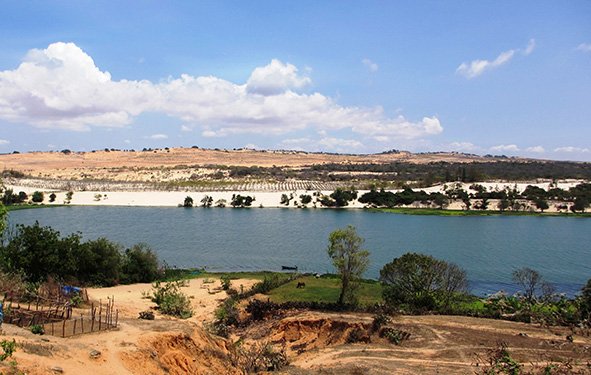To travel through Viet Nam’s South Central Coast, tourists often take National Highway 1A, the backbone of the nation. We however choose a coastal road to explore magnificent landscapes and famous destinations.

A view of Bau Trang lake in the middle of sandy land
We start the journey in La Gi Town in Binh Thuan Province to the north and reach Dinh Thay Thim (Thay Thim Temple) located some 12 kilometers from town. Nestled in the middle of Bau Cat Forest, the temple is a national historical and cultural relic. It was built in 1879 for worshiping a kind hermit (or Thay in Vietnamese) and his wife (or Thim in Vietnamese). Legend has it that they harnessed magical power to treat diseases, suppress rich but dishonest traders and help the poor.
From Dinh Thay Thim, we leave for Ke Ga Cape where the oldest lighthouse of the area overlooks the East Sea. Ke Ga lighthouse was designed by a French architect and completed in 1898. The lighthouse is now a favorite attraction thanks to its magnificent architecture and scenic views.
Continuing our journey, we arrive in the seaside resort town of Phan Thiet. One tourism spot highlighting this city is Phan Thiet Water Tower. Having been existent for more than 70 years, the water tower still stands firmly and elegantly next to the crystal clear Ca Ty River, adding a subtle bit of style to the coastal city.
About six kilometers from Phan Thiet City, we visit Po Sah Inu Cham Tower on a hill top. The tower, which went through historical ups and downs, remains almost intact.
Next, we make it to Mui Ne area, which is home to hundreds of resorts on beautiful white sandy beaches. Mui Ne is an ideal beach area for different water sports.
From Mui Ne, we pass by Hon Rom and reach Hoa Thang T-junction where there are Bau Trang and Bau Sen freshwater lakes with greenery and comfortable breezes described as jewels in the middle of vast sand hills.
Finally, we leave for Phan Ri Cua Town from Bau Trang and Bau Sen to visit Co Thach Pagoda. Nestled amidst the grottoes on a four-hectare rocky hill, 64 meters above sea level, the pagoda is a compound of temples and towers that mingle with a pile of weird shaped boulders that form a natural work of art.
Hang Pagoda is surrounded by primitive trees and mysterious caves. On the winding way to the pagoda, you can see paintings depicting the life of Buddha and Buddhists and buy souvenirs such as teapots, flower vases, jewelry and Buddha statues made of coral, sea snails and rock.